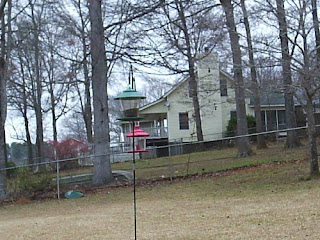At this time of the year I prepare for the annual return of “my colony” of Purple Martins.
I have been a Purple Martin “Landlord” for the past 8-10yrs. I was never quite successful at attracting them when I lived in
Bedford, VA. Maybe because it was further north than
GA. I did see colonies there, though. The birds usually start arriving around the second week of February.
Purple Martins are the largest member of the swallow family in
North America, measuring 7 1/2 inches long and weighing 1.9 ounces. Three races (subspecies) are recognized:
Progne subis breeding in eastern North America and eastern
Mexico;
Progne subis hesperia breeding in the deserts of
Arizona, western
Mexico, and
Baja California; and
Progne subis arboricola breeding along the Pacific coast of the
United States and
Canada, and in the
Rocky Mountains.
Purple Martins spend the non-breeding season in
Brazil then migrate to
North America to nest. East of the
Rockies they are totally dependent on human-supplied housing. West of the
Rockies and in the deserts they largely nest in their ancestral ways, in abandoned woodpecker nest cavities. In the
Pacific northwest, Martins are beginning to use gourds and clusters of single-unit boxes for nesting.
The pair-bond of the Purple Martin is monogamous. The male and female cooperate equally in building the nest out of mud, grass and twigs. The female lays two to seven pure-white eggs at a rate of one egg per day. The female incubates the clutch for approximately fifteen days, then the young hatch. The parents both feed the young continuously for a period of 26-32 days until the young fledge. The young continue to be dependent on their parents for food and training for an additional one to two weeks after fledging. It's not uncommon for the fledglings to return to their human-supplied housing at night to sleep during this period. If you would like to learn more
"Click Here"
The Martins provide Judy and me with hours of peaceful entertainment. They are spectacular flyers as they look for food on the wing. They can out fly their predators, hawks and owls.
The birds have a lovely “dawn song” that may be heard in the early morning hours. Martins are communal birds. They often loudly fuss and fight with each other, but they stick together to face danger. The birds like living in close proximity to humans, probably because they feel safer.
A couple of years ago as Judy and I sat on the screened porch talking, the Martins became extremely agitated. I looked up and saw a “rat snake” all the way up in the gourd rack. We both went in the house to get a rifle. Big mistake!
Where did the snake go?
I had to lower the gourd rack and get on a ladder. Then I had to open the inspection port on the gourds until I found the one with the snake.
We got the snake out and the Martins returned to their gourds after about thirty minutes. I installed a predator guard the next day.
At the end of each season, around the 4th of July I take the gourds down and clean them out along with my Martin House. I clean them and put them away until the the end of Jan. or the first week of Feb. Below is a pic of the plastic gourds I use. Most of my gourds are S&K Bo 9's with a 3" tunnel. The tunnel provides additional protection from hawks and owls.
I always put some pine straw into each of the gourds and the house apts. It provides a little insulation from the cold surfaces. The Martins will construct their own nest after they pair up and get ready to raise a family!
The gourds are now on the rack but not raised up. The gourds are on a telescoping pole that I will extend to approx 14 feet once the birds arrive.
After I prepared the gourd rack, I put nesting material in the "house apts" and attached four gourds. I modified the Martin House from twelve apts to five. By doing this I increased the apt size from 6 inches to 12 inches. I did this to increase the protection from predators. Between the gourd rack and house and gourds, the colony can accommodate 21 pairs. Each pair of Martins produce an average five offsprings. It gets crowded.
House raised up about 2/3 of the way.
This year I got a surprise when I took the gourds out of storage from the overhead of my boat house. It looks like a squirrel made a home or two in the gourds. It destroyed three tunnels and a couple of gourds!
I'll let you know when the PMs show up. Could be any day now since we have had such a mild winter. They usually get here around mid Feb. Thanks for stopping by. Comments are always welcomed.
Next post will be Mon.















































